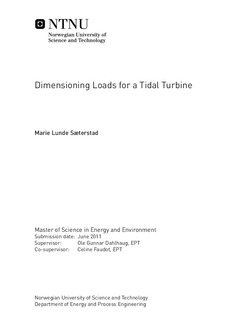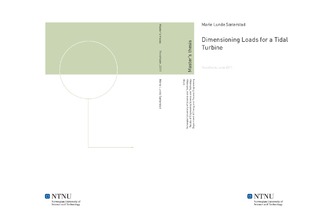| dc.contributor.advisor | Dahlhaug, Ole Gunnar | nb_NO |
| dc.contributor.advisor | Faudot, Celine | nb_NO |
| dc.contributor.author | Sæterstad, Marie Lunde | nb_NO |
| dc.date.accessioned | 2014-12-19T11:46:42Z | |
| dc.date.available | 2014-12-19T11:46:42Z | |
| dc.date.created | 2011-09-15 | nb_NO |
| dc.date.issued | 2011 | nb_NO |
| dc.identifier | 441336 | nb_NO |
| dc.identifier | ntnudaim:6296 | nb_NO |
| dc.identifier.uri | http://hdl.handle.net/11250/234358 | |
| dc.description.abstract | The main dynamic loads on a tidal turbine are due to the tidal current variation, turbulence, wave-current interaction and wake from the tower and upstream turbines. The design of the turbine is highly dependent on the dynamic loads acting on the turbine's blades and its structure. Cyclic loading and unloading of any material over a period of time will lead to fatigue and structural damage. In this work dimensioning loads for NTNU's 1 MW reference tidal turbine are calculated due to the vertical no-slip current velocity profile, wave-current interaction, the horizontal and vertical velocity component due to the waves, turbulence and the tidal wave. Based on mathematical models the dimensioning loads for the turbine are calculated with a Matlab code written for this work. The influence of each of the components causing a dynamic load on the tidal turbine blades is evaluated and analyzed with the rainflow counting algorithm, which can be used for fatigue analysis.Results from Matlab calculations are compared to experimental results in order to validate the Matlab code. In the comparison the trends are the same for calculation and experimental results, oscillating curves with the same period. It is noticed that in large waves the Matlab code predicts very well the dynamic loads in terms of mean and peak-to-peak values.For the thrust force and the shaft torque the horizontal component of the velocity due to the waves has the largest influence on the peak-to-peak values and the turbulence induces a high number of cycles. For the pitch moment as well the horizontal component due to the waves has the largest influence on the peak-to-peak values, but also the vertical component has a certain influence. For the pitch moment the consistently main oscillations inducing cyclic loading are due to the vertical no-slip current velocity profile. This is also the case for the yaw moment, but here the vertical wave component has the largest influence on the peak-to-peak values. For calculation with the tidal wave it is noticed that higher velocities gives higher maximum values. The Matlab code is a reliable and fast tool. Despite the simplifications done in the calculations, it calculates the dimensioning loads for a tidal turbine with a good accuracy. | nb_NO |
| dc.language | eng | nb_NO |
| dc.publisher | Institutt for energi- og prosessteknikk | nb_NO |
| dc.subject | ntnudaim:6296 | no_NO |
| dc.subject | MTENERG energi og miljø | no_NO |
| dc.subject | Varme- og energiprosesser | no_NO |
| dc.title | Dimensioning Loads for a Tidal Turbine | nb_NO |
| dc.type | Master thesis | nb_NO |
| dc.source.pagenumber | 142 | nb_NO |
| dc.contributor.department | Norges teknisk-naturvitenskapelige universitet, Fakultet for ingeniørvitenskap og teknologi, Institutt for energi- og prosessteknikk | nb_NO |

